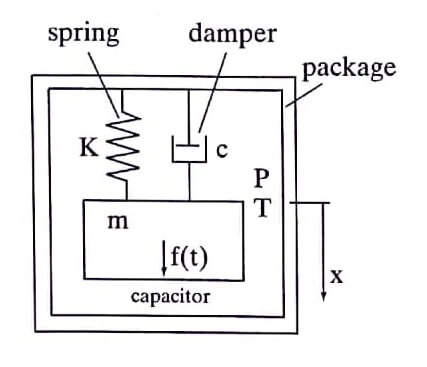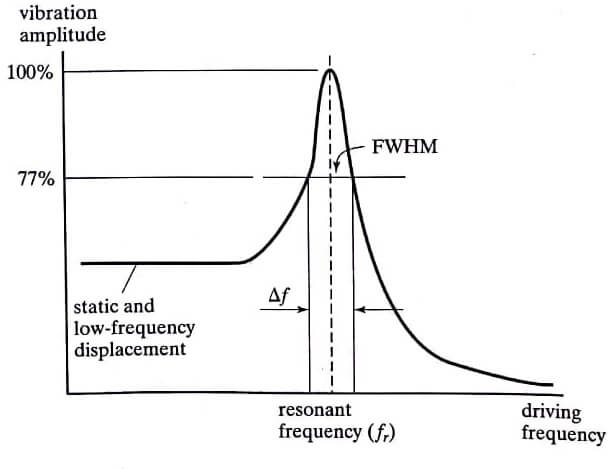A MEMS system, including sensors and actuators, invariably consists of mass and supporting structures. The supporting mechanical elements (membranes, cantilever, or suspensions) provide elastic restoring spring constants.
Movement of the mass is impeded by collision with air molecules surrounding the mass. This constitutes damping, which is a velocity-dependant resistance force.
As such, a MEMS system can always be simplified into a classic mass-spring-damper system. It is almost always subject to time varying input, dynamic input (pulses or shocks) and sinusoidal (resonant) input signals.
The understanding of MEMS system dynamics is crucial for predicting performance characteristics of sensors and actuators. Dynamic analysis is discussed in many books. In this section, only the most essential elements of dynamic system behavior are discussed.
Dynamic System and Governing Equation
The governing equation of a mass-spring-damper system shown in figure is
![]()
where the term c is the damping coefficient, k is the force constant (spring constant), and f(t) is the forcing function. Dividing both sides with the mass m, we arrive at a canonic expression
![]()
where the term
![]()

is the natural resonant frequency and the term
![]()
is the damping ratio.
The term
![]()
is called the critical damping coefficient.
The solution method for the governing differential equation would be different for dif. ferent input:
- If f(t), the solution is called the free system solution.
- If f(t) is an arbitraty forcing function, the solution may contain both transient and steady state terms.
- If f(t), A sin ωt the system is said to be under sinusoidal or resonant forcing.
In this section, we only focus on reviewing the response of the system under sinusoidal input. Readers who wish to become familiar with dynamic system responses can refer to textbooks on this subjects and Appendix 3.
Response Under Sinusoidal Resonant Input
For sinusoidal forcing, the system will be forced to oscillate with the forcing frequency. The steady-state response is the focus of analysis. Under a sinusoidal input,
f(t) = F sin (ωt) = ma sin (ωt)
the steady-state system output will be a sinusoidal signal with the same frequency as the driving frequency, namely
x = A sin (ωt + φ).
Therefore, transient response and any initial conditions don’t matter anymore. The output can be analyzed using the transfer function method. In this case, the transfer function between x and f is
![]()
Dividing the numerator and the denominator with m, we have
![]()
If one replaces s with jω, the spectral response of T is
![]()
The magnitude A is therefore
![]()
The term F/m is the would-be amplitude under DC forcing conditions. The magnitude A is a function of both the frequency ω and damping ratio ζ.
A second order system responds differently to stimulus depending on if the system damping is large or small:
for large damping c, the system is said to be over damped;
the system is said to be critically damped if c = 2√km or ξ = 1;
when the damping is between critical damping and zero, the system is said to be under damped.
If we fix ξ and change ω, we can plot a typical frequency spectrum of the response. The displacement of an underdamped mechanical structure under a periodic loading condition is shown in figure.
At low frequencies, the displacement remains constant. This represents the low-frequency behavior that applies to the steady loading case. At or near the resonant frequency (fr, with fr = ωn/2π), the mechanical vibration amplitude sharply increases. The sharpness of the resonant peak is characterized by a term called the quality factor (Q). The sharper the resonance peak, the higher the quality factor.
The amplitude magnification at the resonant frequency can be beneficial. By operating a micro sensor or actuator at the resonant frequency may increase the sensitivity or range of actuation.
However, resonance may also lead to self-destruction of mechanical elements.
At frequencies beyond the resonant frequency, the vibration amplitude decreases (called roll off). A simple physical explanation is that the mechanical structures, with its built-in inertia, cannot follow the driving input anymore at frequencies significantly above the fr.

Damping and Quality Factor
MEMS moving masses encounter damping invariably. Damping may be derived from both viscously fluid interaction [49] (such as squeeze film damping [49-53] and collision with gas particles [54]) and structural damping (internal friction) [55].
The damping factors are there. fore subjected to temperature, pressure, types of gas molecule, and other environmental factors [56-58].
The quality factor, representing the sharpness of resonance peaks, can be defined in several ways Mathematically, the quality factor is related to the full width at half maximum (FWHM). which is the spacing of two frequencies at half power (or 77% amplitude). The ratio of the resonant frequency and the FWHM gives the quality factor.
![]()
From the energy point of view, Q is the ratio of the total stored energy in a system over the energy lost over each cycle of oscillation. The lower the energy loss per cycle, the greater the quality factor.
Mathematically, the quality factor is related to the damping factor, by
![]()
Hence the quality factor is inversely proportional to the damping. A small value of damping coefficient c translates into lower energy loss, smaller damping ratio, and hence higher Q.
As such, the quality factor of a micro device can be improved by reducing the operating pressure [12,59], by altering the operating temperature [12] , by improving surface roughness [60]. by thermal annealing (up to 600% improvement demonstrated in [61]), or by modifying the boundary conditions [62,63]. Q value for micromechanical devices ranging from several hundred [64] to up to 10,000 [63-65] have been demonstrated in micro- or nano mechanical resonators.
Resonant Frequency and Bandwidth
The resonant frequency determines the ultimately achievable bandwidth of a device. Hence for many devices, a greater resonant frequency is desired. Formula for calculating the resonant frequency of cantilevers under various boundary and loading conditions can be found in Appendix B.
The resonant frequency of mechanical elements generally increases when scaled down, as the value of m decreases rapidly. By down-scaling resonator device dimensions, resonant frequency ranging form several MHz [65], tens of MHz [63], and even to the GHz range [60] has been demonstrated successfully.
Because the resonance frequency is a function of device dimensions, it is susceptible to changes in temperature. Temperature stabilization is critical for resonators requiring stable frequency. For commercial devices, temperature stability must be achieved by temperature compensation [66].
Additionally, the resonant frequency of micro resonators can be precisely tuned by trimming materials (using laser or focused ion beam etching), or by depositing materials [67].
| Read More Topics |
| Conductivity of Semiconductor |
| Microelectronics fabrication process flow |
| Reactive ion etching |
| Vibration galvanometer |





